light YAMAHA XV535 2000 Owners Manual
[x] Cancel search | Manufacturer: YAMAHA, Model Year: 2000, Model line: XV535, Model: YAMAHA XV535 2000Pages: 87, PDF Size: 17.84 MB
Page 11 of 87
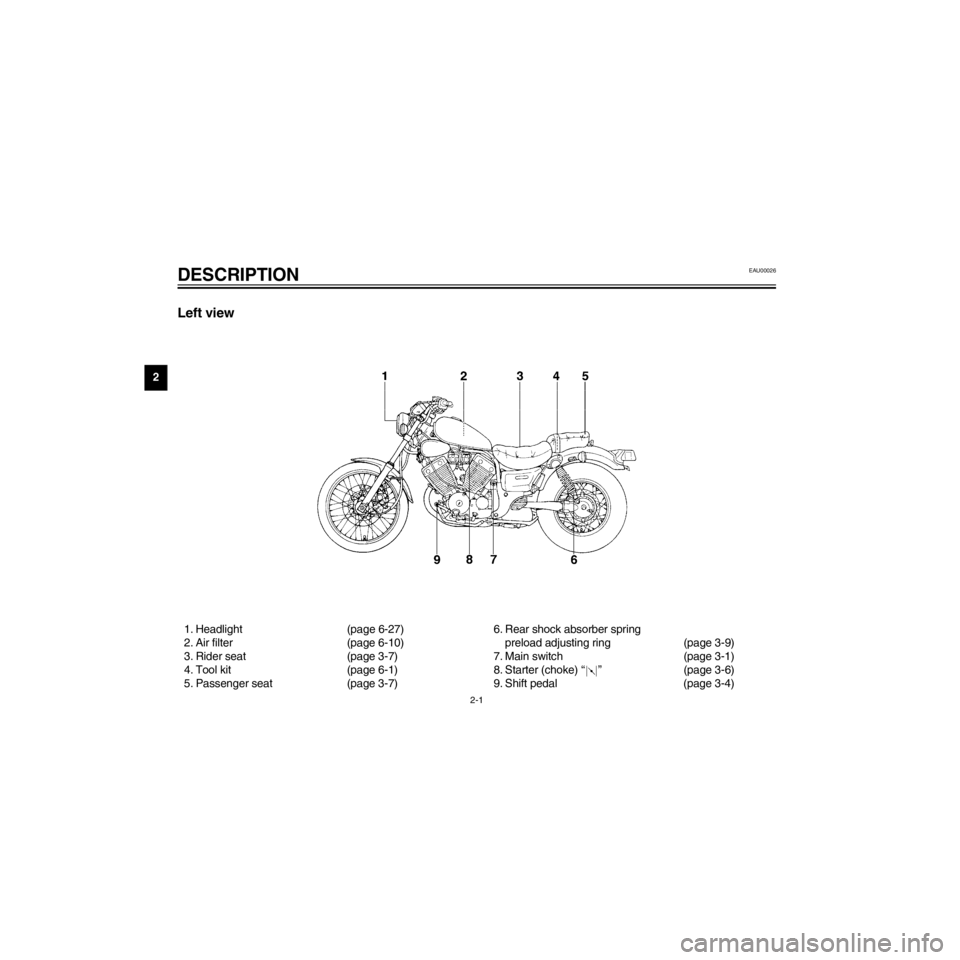
L
2-1
DESCRIPTION
/Net/layout8/layout_G2/work/Imai_work/OM-PS/AA9149_XV535-E6/English/E-2.frame
Left view
EAU00026
1. Headlight (page 6-27)
2. Air filter (page 6-10)
3. Rider seat (page 3-7)
4. Tool kit (page 6-1)
5. Passenger seat (page 3-7)6. Rear shock absorber spring
preload adjusting ring (page 3-9)
7. Main switch (page 3-1)
8. Starter (choke) Ò Ó (page 3-6)
9. Shift pedal (page 3-4)
Page 12 of 87
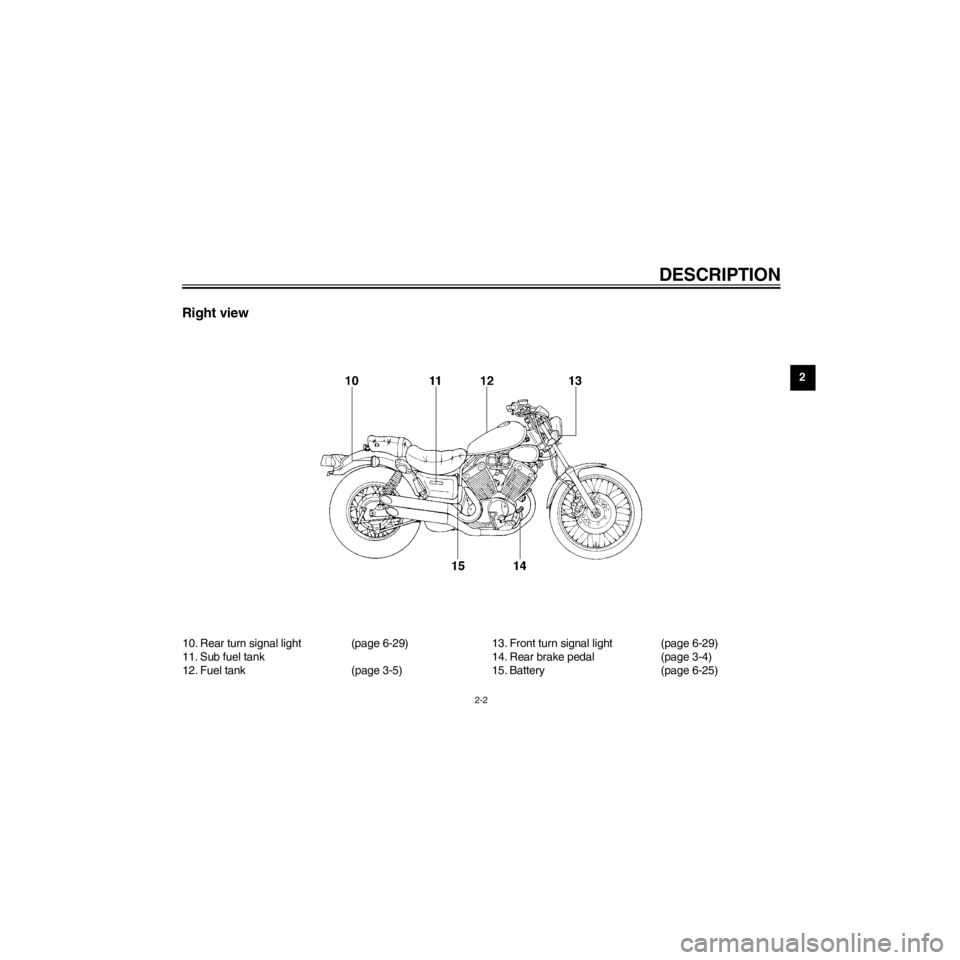
R
2-2
DESCRIPTION
/Net/layout8/layout_G2/work/Imai_work/OM-PS/AA9149_XV535-E6/English/E-2.frame
Right view
10. Rear turn signal light (page 6-29)
11. Sub fuel tank
12. Fuel tank (page 3-5)13. Front turn signal light (page 6-29)
14. Rear brake pedal (page 3-4)
15. Battery (page 6-25)
Page 14 of 87

R
INSTRUMENT AND CONTROL FUNCTIONS
/Net/layout8/layout_G2/work/Imai_work/OM-PS/AA9149_XV535-E6/English/E-3TOC.frame
Main switch ........................................................................................ 3-1
Indicator lights .................................................................................... 3-1
Speedometer...................................................................................... 3-2
Handlebar switches ............................................................................ 3-2
Clutch lever ........................................................................................ 3-3
Shift pedal .......................................................................................... 3-4
Front brake lever ................................................................................ 3-4
Rear brake pedal................................................................................ 3-4
Fuel tank cap...................................................................................... 3-5
Fuel .................................................................................................... 3-5
Starter (choke) Ò Ó........................................................................... 3-6
Steering lock ...................................................................................... 3-6
Seats .................................................................................................. 3-7
Helmet holder ..................................................................................... 3-8
Rear shock absorber adjustment ....................................................... 3-9
Sidestand ........................................................................................... 3-9
Sidestand/clutch switch operation check ......................................... 3-10
Page 15 of 87
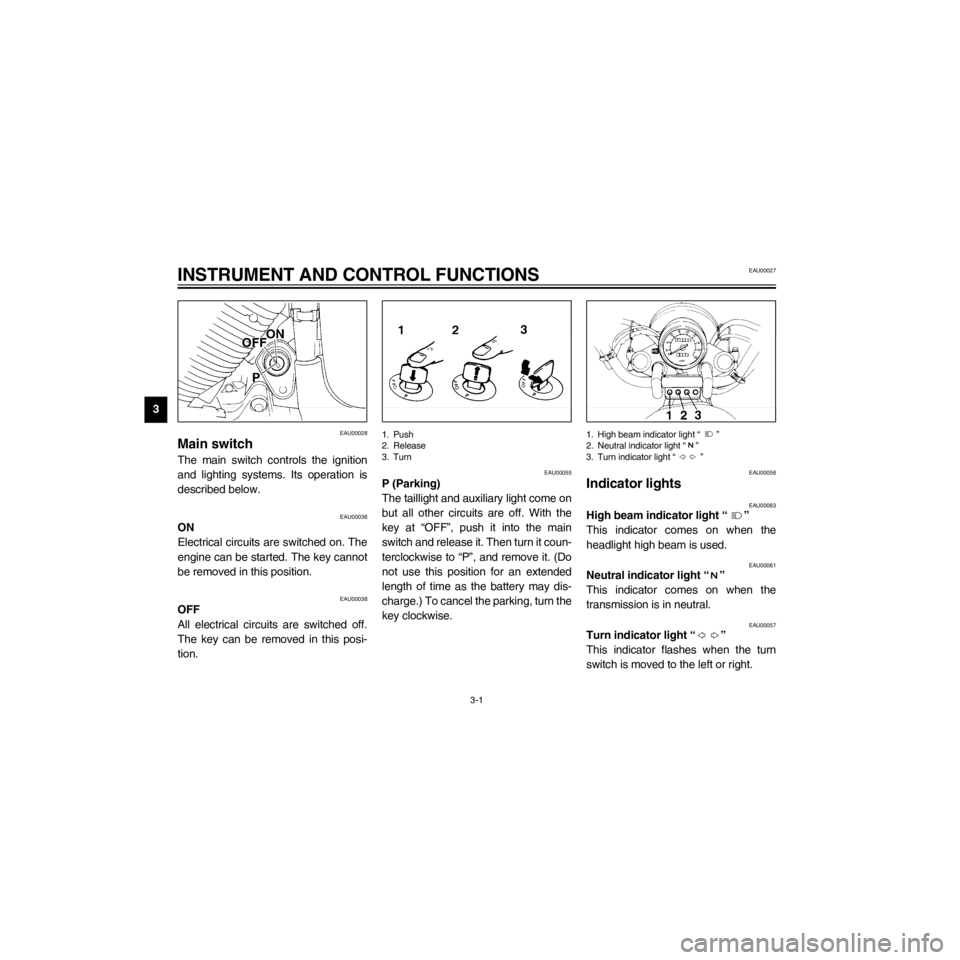
L
3-1
INSTRUMENT AND CONTROL FUNCTIONS
/Net/layout8/layout_G2/work/Imai_work/OM-PS/AA9149_XV535-E6/English/E-3.frame
EAU00027
EAU00028
Main switch
The main switch controls the ignition
and lighting systems. Its operation is
described below.
EAU00036
ON
Electrical circuits are switched on. The
engine can be started. The key cannot
be removed in this position.
EAU00038
OFF
All electrical circuits are switched off.
The key can be removed in this posi-
tion.
1. Push
2. Release
3. Turn
EAU00055
P (Parking)
The taillight and auxiliary light come on
but all other circuits are off. With the
key at ÒOFFÓ, push it into the main
switch and release it. Then turn it coun-
terclockwise to ÒPÓ, and remove it. (Do
not use this position for an extended
length of time as the battery may dis-
charge.) To cancel the parking, turn the
key clockwise.
1. High beam indicator light Ò Ó
2. Neutral indicator light Ò Ó
3. Turn indicator light Ò Ó
EAU00056
Indicator lights
EAU00063
High beam indicator light Ò Ó
This indicator comes on when the
headlight high beam is used.
EAU00061
Neutral indicator light Ò Ó
This indicator comes on when the
transmission is in neutral.
EAU00057
Turn indicator light Ò Ó
This indicator flashes when the turn
switch is moved to the left or right.
Page 16 of 87
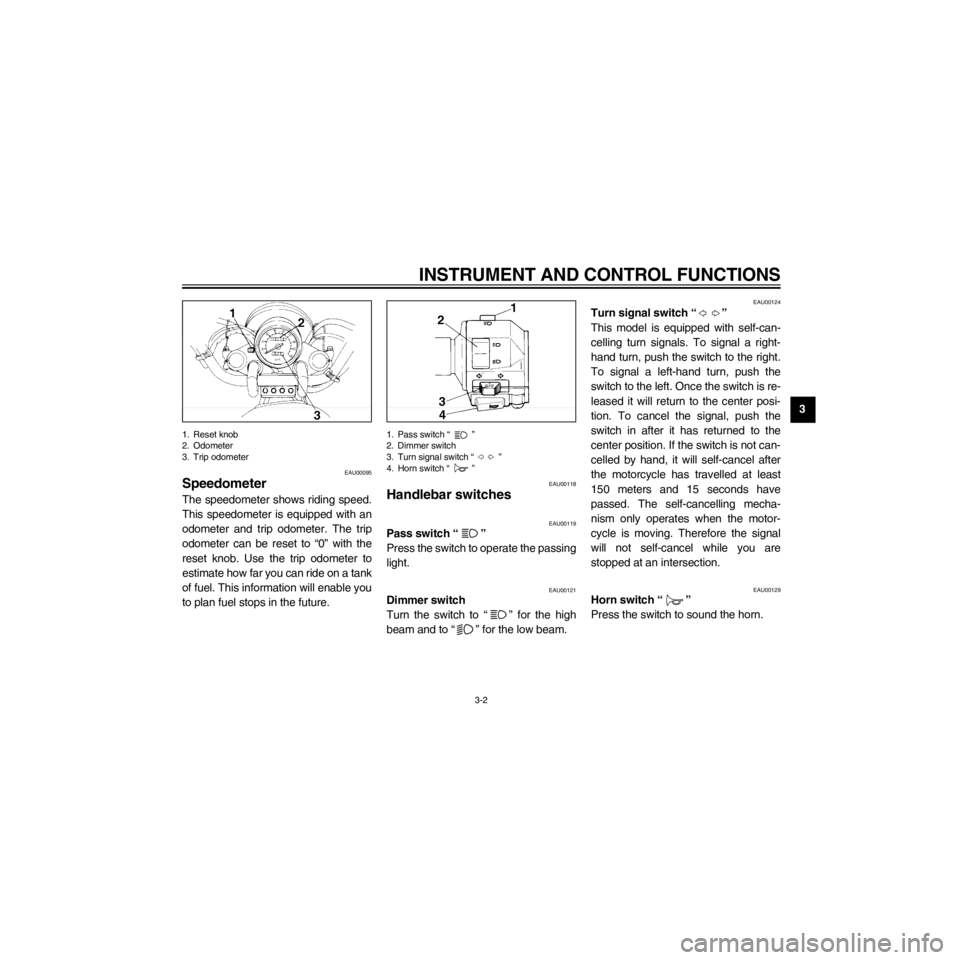
R
3-2
INSTRUMENT AND CONTROL FUNCTIONS
/Net/layout8/layout_G2/work/Imai_work/OM-PS/AA9149_XV535-E6/English/E-3.frame
1. Reset knob
2. Odometer
3. Trip odometer
EAU00095
Speedometer
The speedometer shows riding speed.
This speedometer is equipped with an
odometer and trip odometer. The trip
odometer can be reset to Ò0Ó with the
reset knob. Use the trip odometer to
estimate how far you can ride on a tank
of fuel. This information will enable you
to plan fuel stops in the future.
1. Pass switch Ò Ó
2. Dimmer switch
3. Turn signal switch Ò Ó
4. Horn switch Ò Ó
EAU00118
Handlebar switches
EAU00119
Pass switch Ò Ó
Press the switch to operate the passing
light.
EAU00121
Dimmer switch
Turn the switch to Ò Ó for the high
beam and to Ò Ó for the low beam.
EAU00124
Turn signal switch Ò Ó
This model is equipped with self-can-
celling turn signals. To signal a right-
hand turn, push the switch to the right.
To signal a left-hand turn, push the
switch to the left. Once the switch is re-
leased it will return to the center posi-
tion. To cancel the signal, push the
switch in after it has returned to the
center position. If the switch is not can-
celled by hand, it will self-cancel after
the motorcycle has travelled at least
150 meters and 15 seconds have
passed. The self-cancelling mecha-
nism only operates when the motor-
cycle is moving. Therefore the signal
will not self-cancel while you are
stopped at an intersection.
EAU00129
Horn switch Ò Ó
Press the switch to sound the horn.
Page 17 of 87
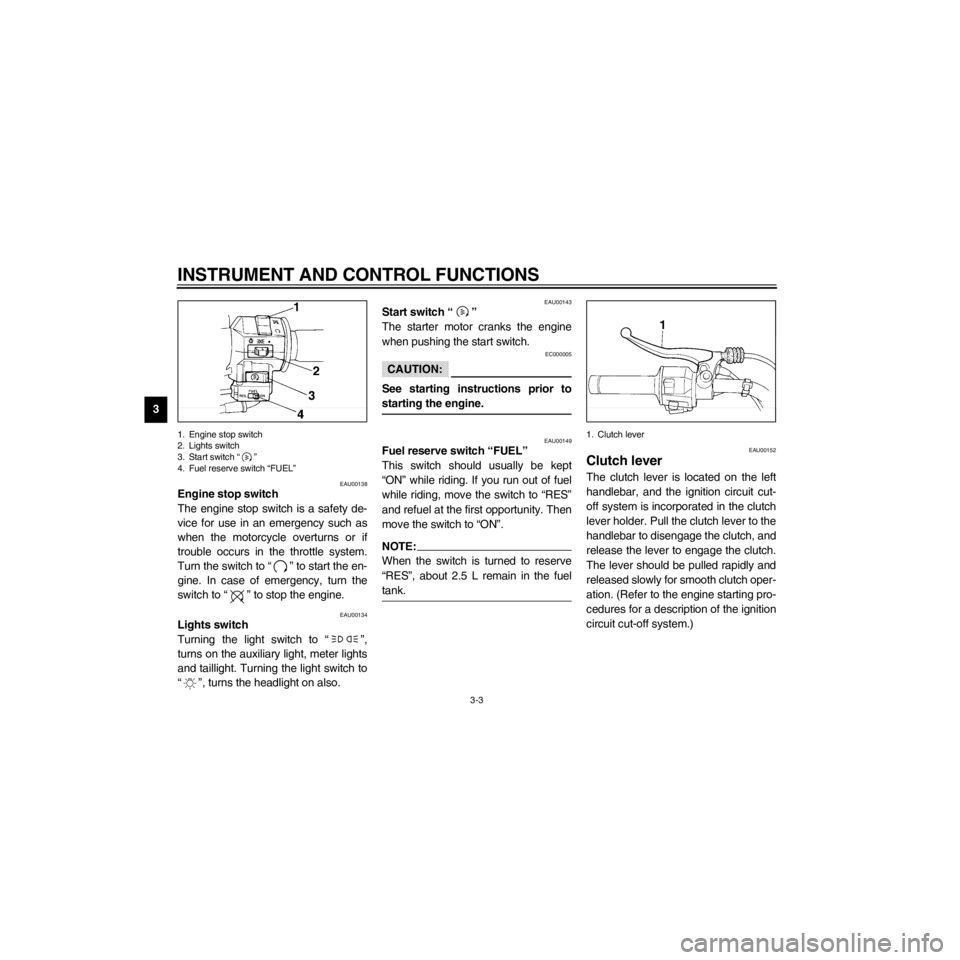
L
3-3
INSTRUMENT AND CONTROL FUNCTIONS
/Net/layout8/layout_G2/work/Imai_work/OM-PS/AA9149_XV535-E6/English/E-3.frame
1. Engine stop switch
2. Lights switch
3. Start switch Ò Ó
4. Fuel reserve switch ÒFUELÓ
EAU00138
Engine stop switch
The engine stop switch is a safety de-
vice for use in an emergency such as
when the motorcycle overturns or if
trouble occurs in the throttle system.
Turn the switch to Ò Ó to start the en-
gine. In case of emergency, turn the
switch to Ò Ó to stop the engine.
EAU00134
Lights switch
Turning the light switch to Ò Ó,
turns on the auxiliary light, meter lights
and taillight. Turning the light switch to
Ò Ó, turns the headlight on also.
EAU00143
Start switch Ò Ó
The starter motor cranks the engine
when pushing the start switch.
EC000005
CAUTION:
See starting instructions prior to
starting the engine.
EAU00149
Fuel reserve switch ÒFUELÓ
This switch should usually be kept
ÒONÓ while riding. If you run out of fuel
while riding, move the switch to ÒRESÓ
and refuel at the first opportunity. Then
move the switch to ÒONÓ.
When the switch is turned to reserve
ÒRESÓ, about 2.5 L remain in the fuel
tank.
1. Clutch lever
EAU00152
Clutch lever
The clutch lever is located on the left
handlebar, and the ignition circuit cut-
off system is incorporated in the clutch
lever holder. Pull the clutch lever to the
handlebar to disengage the clutch, and
release the lever to engage the clutch.
The lever should be pulled rapidly and
released slowly for smooth clutch oper-
ation. (Refer to the engine starting pro-
cedures for a description of the ignition
circuit cut-off system.)
Page 20 of 87
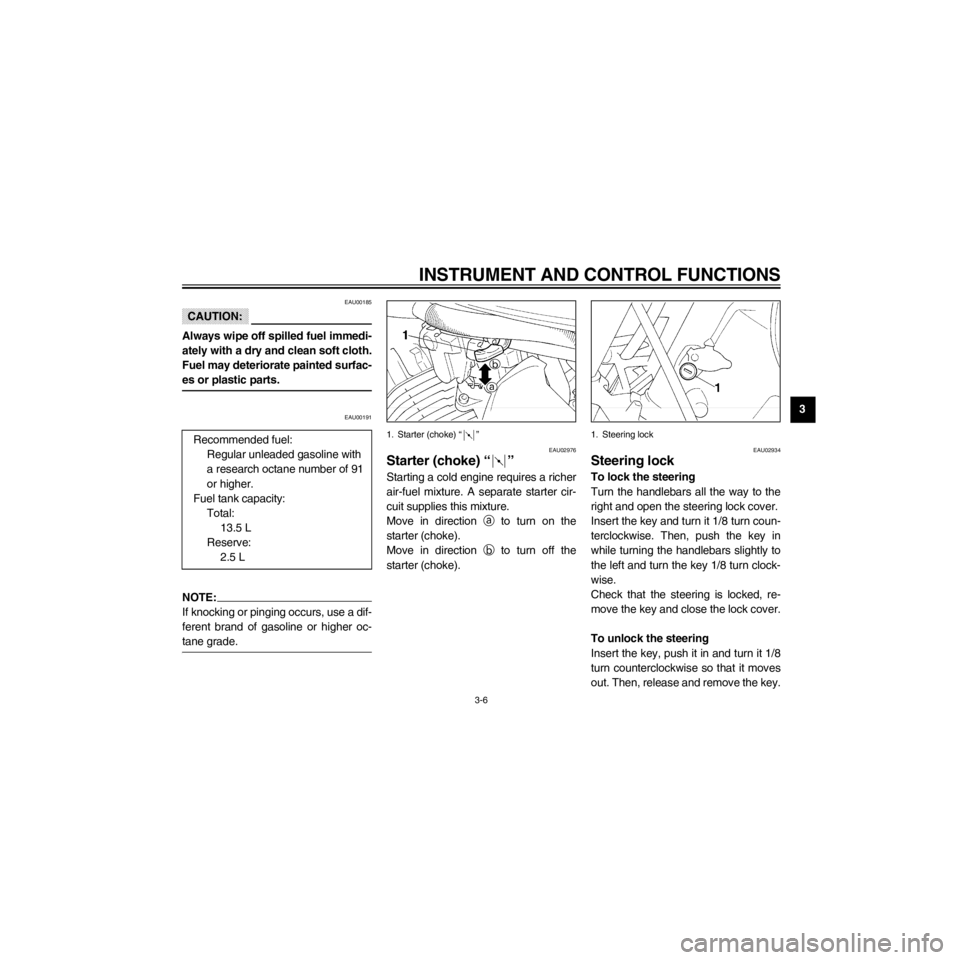
R
3-6
INSTRUMENT AND CONTROL FUNCTIONS
/Net/layout8/layout_G2/work/Imai_work/OM-PS/AA9149_XV535-E6/English/E-3.frame
EAU00185
CAUTION:
Always wipe off spilled fuel immedi-
ately with a dry and clean soft cloth.
Fuel may deteriorate painted surfac-
es or plastic parts.
EAU00191
NOTE:
If knocking or pinging occurs, use a dif-
ferent brand of gasoline or higher oc-
tane grade.Recommended fuel:
Regular unleaded gasoline with
a research octane number of 91
or higher.
Fuel tank capacity:
Total:
13.5 L
Reserve:
2.5 L
1. Starter (choke) Ò Ó
EAU02976
Starter (choke) Ò Ó
Starting a cold engine requires a richer
air-fuel mixture. A separate starter cir-
cuit supplies this mixture.
Move in direction a
to turn on the
starter (choke).
Move in direction b
to turn off the
starter (choke).
1. Steering lock
EAU02934
Steering lock
To lock the steering
Turn the handlebars all the way to the
right and open the steering lock cover.
Insert the key and turn it 1/8 turn coun-
terclockwise. Then, push the key in
while turning the handlebars slightly to
the left and turn the key 1/8 turn clock-
wise.
Check that the steering is locked, re-
move the key and close the lock cover.
To unlock the steering
Insert the key, push it in and turn it 1/8
turn counterclockwise so that it moves
out. Then, release and remove the key.
Page 28 of 87

R
4-2
PRE-OPERATION CHECKS
/Net/layout8/layout_G2/work/Imai_work/OM-PS/AA9149_XV535-E6/English/E-4.frame
NOTE:
Pre-operation checks should be made each time the motorcycle is used. Such an inspection can be thoroughly accom-
plished in a very short time; and the added safety it assures is more than worth the time involved.
If any item in the PRE-OPERATION CHECK is not working properly, have it inspected and repaired before operating
the motorcycle.
Sidestand pivot¥ Check for smooth operation.
¥ Lubricate if necessary.6-23
Chassis fasteners¥ Make sure that all nuts, bolts and screws are properly tightened.
¥ Tighten if necessary.Ñ
Fuel tank¥ Check fuel level.
¥ Fill with fuel if necessary.3-5 ~ 3-6
Lights, signals and
switches¥ Check for proper operation. 6-27 ~ 6-29
Battery¥ Check fluid level.
¥ Fill with distilled water if necessary.6-25 ~ 6-26 ITEM CHECKS PAGE
Page 33 of 87
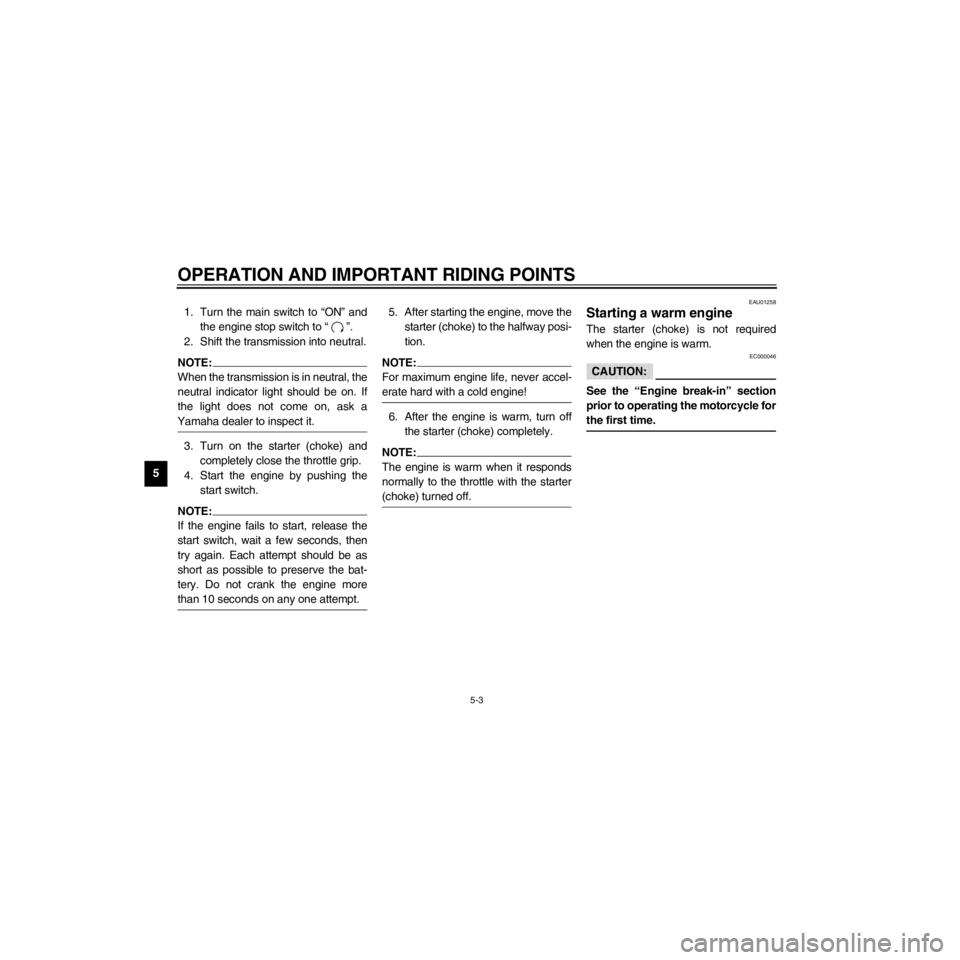
L
5-3
OPERATION AND IMPORTANT RIDING POINTS
/Net/layout8/layout_G2/work/Imai_work/OM-PS/AA9149_XV535-E6/English/E-5.frame
1. Turn the main switch to ÒONÓ and
the engine stop switch to Ò Ó.
2. Shift the transmission into neutral.
NOTE:
When the transmission is in neutral, the
neutral indicator light should be on. If
the light does not come on, ask a
Yamaha dealer to inspect it.
3. Turn on the starter (choke) and
completely close the throttle grip.
4. Start the engine by pushing the
start switch.
NOTE:
If the engine fails to start, release the
start switch, wait a few seconds, then
try again. Each attempt should be as
short as possible to preserve the bat-
tery. Do not crank the engine more
than 10 seconds on any one attempt.
5. After starting the engine, move the
starter (choke) to the halfway posi-
tion.
NOTE:
For maximum engine life, never accel-
erate hard with a cold engine!
6. After the engine is warm, turn off
the starter (choke) completely.
NOTE:
The engine is warm when it responds
normally to the throttle with the starter
(choke) turned off.
EAU01258
Starting a warm engine
The starter (choke) is not required
when the engine is warm.
EC000046
CAUTION:
See the ÒEngine break-inÓ section
prior to operating the motorcycle for
the first time.
Page 34 of 87
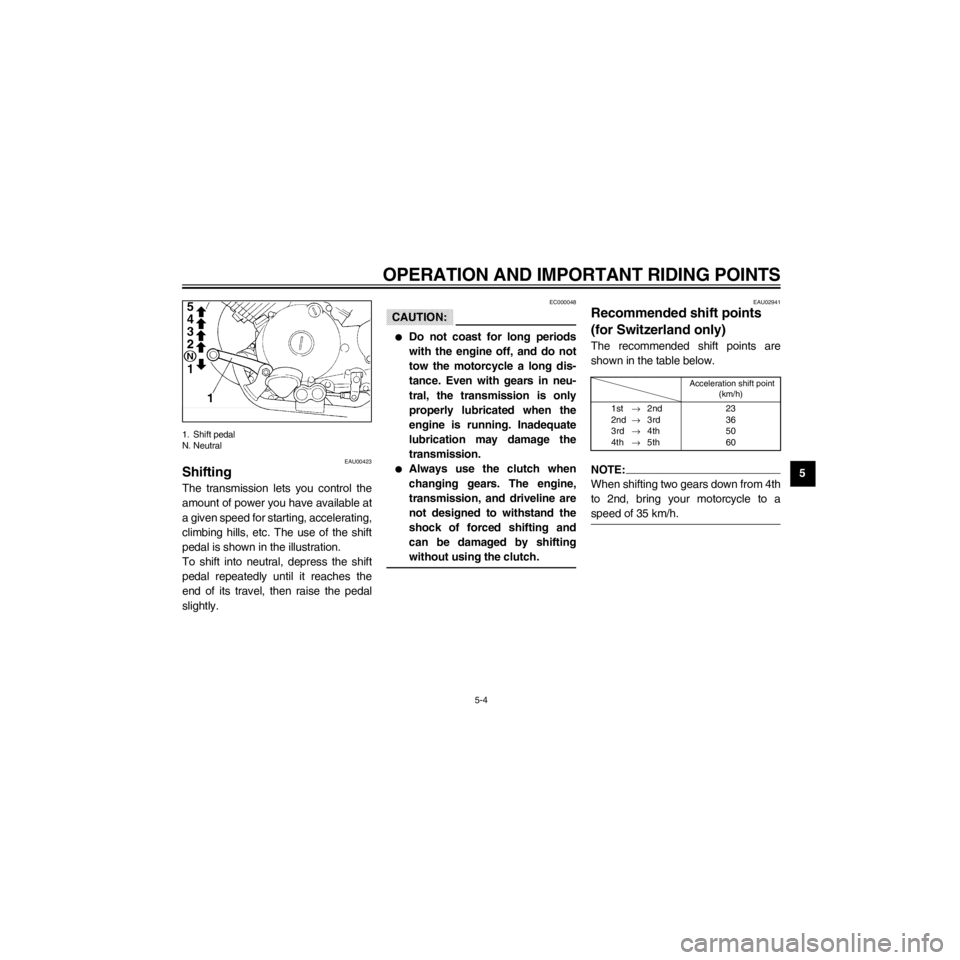
R
5-4
OPERATION AND IMPORTANT RIDING POINTS
/Net/layout8/layout_G2/work/Imai_work/OM-PS/AA9149_XV535-E6/English/E-5.frame
1. Shift pedal
N. Neutral
EAU00423
Shifting
The transmission lets you control the
amount of power you have available at
a given speed for starting, accelerating,
climbing hills, etc. The use of the shift
pedal is shown in the illustration.
To shift into neutral, depress the shift
pedal repeatedly until it reaches the
end of its travel, then raise the pedal
slightly.
EC000048
CAUTION:
lDo not coast for long periods
with the engine off, and do not
tow the motorcycle a long dis-
tance. Even with gears in neu-
tral, the transmission is only
properly lubricated when the
engine is running. Inadequate
lubrication may damage the
transmission.
lAlways use the clutch when
changing gears. The engine,
transmission, and driveline are
not designed to withstand the
shock of forced shifting and
can be damaged by shifting
without using the clutch.
EAU02941
Recommended shift points
(for Switzerland only)
The recommended shift points are
shown in the table below.
NOTE:
When shifting two gears down from 4th
to 2nd, bring your motorcycle to a
speed of 35 km/h.
Acceleration shift point
(km/h)
1st®2nd
2nd®3rd
3rd®4th
4th®5th23
36
50
60